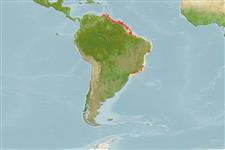Environment: milieu / climate zone / depth range / distribution range
Ecologia
marinhas; Água doce; estuarina; intervalo de profundidade ? - 40 m (Ref. 188). Tropical; 12°N - 26°S, 64°W - 33°W (Ref. 188)
Western Atlantic: Trinidad and the Guianas; from Sergipe south to about Rio de Janeiro. Also found in freshwater. Also southern Brazil (Ref. 26938).
Tamanho / Peso / Idade
Maturity: Lm ? range ? - ? cm
Max length : 22.0 cm TL macho/indeterminado; (Ref. 125970); common length : 12.0 cm TL macho/indeterminado; (Ref. 5217); peso máx. publicado: 114.60 g (Ref. 125970)
Descrição suscinta
Chaves de identificação | Morfologia | Morfometria
Espinhos dorsais (total) : 0; Espinhos anais: 0; Raios anais : 70 - 85. Belly with a keel of scutes, but interrupted below pectoral fin base; scutes 7 or 8, then a gap, followed by 10 to 13, the outer edges of scutes smooth and not serrated. Upper jaw broad at midpoint, tapering posteriorly, the tip reaching or surpassing gill opening; no hypo-maxilla. Pectoral fins large; dorsal fin very small, set far back on body; anal fin long (Ref. 188). Sides of head silvery (Ref. 37032).
Occurs inshore, off river mouths, in estuaries, and some distance up rivers in freshwater (e.g., up Coppename River near Wilhelmina Mts, Suriname). Found over sand and mud bottom (Ref. 5217). Possibly spawns in rivers. Utilized as a food fish at some localities (Ref. 5217).
Ciclo de vida ou comportamento de acasalamento
Maturidade | Reprodução | Desova | Ovos | Fecundidade | Larvas
Whitehead, P.J.P., 1985. FAO Species Catalogue. Vol. 7. Clupeoid fishes of the world (suborder Clupeoidei). An annotated and illustrated catalogue of the herrings, sardines, pilchards, sprats, shads, anchovies and wolf-herrings. FAO Fish. Synop. 125(7/1):1-303. Rome: FAO. (Ref. 188)
Status na Lista Vermelha da UICN (Ref. 130435: Version 2024-2)
Ameaça para os humanos
Harmless
Uso pelos humanos
Pescarias: pouco comercial
Ferramentas
Relatórios especiais
Baixar XML
Fontes da internet
Estimates based on models
Preferred temperature (Ref.
123201): 24.9 - 27.8, mean 27.3 °C (based on 84 cells).
Índice de diversidade filogenética (Ref.
82804): PD
50 = 0.6250 [Uniqueness, from 0.5 = low to 2.0 = high].
Bayesian length-weight: a=0.00389 (0.00277 - 0.00546), b=3.04 (2.95 - 3.13), in cm total length, based on LWR estimates for this species (Ref.
93245).
Nível Trófico (Ref.
69278): 3.5 ±0.5 se; based on size and trophs of closest relatives
Generation time: 3.1 ( na - na) years. Estimated as median ln(3)/K based on 1
growth studies.
Resiliência (Ref.
120179): médio(a), tempo mínimo de duplicação da população 1,4 - 4,4 anos (K=0.35).
Fishing Vulnerability (Ref.
59153): Low vulnerability (12 of 100).
Nutrients (Ref.
124155): Calcium = 195 [123, 416] mg/100g; Iron = 1.5 [0.9, 2.5] mg/100g; Protein = 18.5 [17.0, 19.9] %; Omega3 = 0.259 [0.128, 0.505] g/100g; Selenium = 34 [16, 75] μg/100g; VitaminA = 48 [18, 117] μg/100g; Zinc = 1.77 [1.23, 2.44] mg/100g (wet weight);
